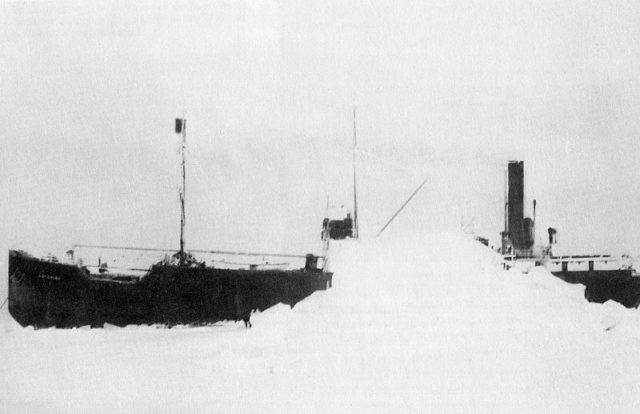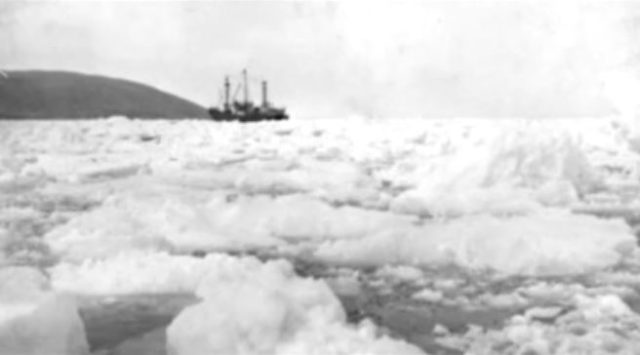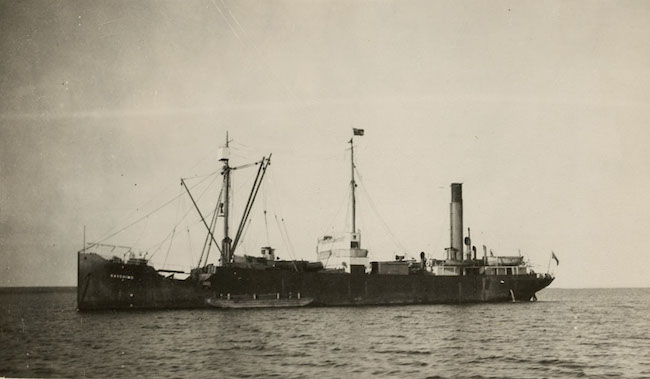A steel hulled cargo steamer from Sweden sailed the waters off the coast of Alaska alone and crew-less for thirty-eight years.
The SS Baychimo, a 1,322-ton cargo ship launched in 1914 was originally called the Ångermanelfven. It was built at the Lindholmens shipyard in Gothenburg, Sweden.
Intended for the Baltische Reederei GmbH of Hamburg, it was used for trade between Hamburg and Sweden until 1914. The 230-foot long ship, powered by a coal burning triple expansion steam engine reached a top speed of 12 miles per hour.

After World War I Germany’s reparations for shipping losses included transferring the ship to Great Britain’s Hudson Bay Company in 1921.
It was renamed “Baychimo” and found a new home in Ardrossan, Scotland. She collected fur pelts, and every summer went back and forth between trading posts along the coast of Canada trading for tobacco, sugar, tea and weapons.
In 1924 the ship circumnavigated the globe and continued carrying furs and supplies until 1931 when the crew found itself trapped in an early season icepack at the end of a trade run.
The men hiked for a half mile over the ice to Barrow, Alaska to wait a few days for the ice to break up so they could continue on to the next post.
A week later the ice trapped the ship again. Most of the crew was airlifted to safety, but a few remained behind in a hastily constructed shack to keep watch over the ship fully expecting to remain there for the duration of winter.
According to Arctic historian, Kenn Harper in a column in the Nunatsiaq News, the captain “sent a wireless message for an aircraft to take out most of his men.
The remaining crew built huts on the beach. Baychimo was only a half-mile offshore.
Their plan was to remain near the ship and sail her out the following summer. On Nov. 24, the temperature rose dramatically, from minus 60 to zero.
A blizzard raged for three days, and no man dared venture out of his shack. When the storm abated, there was no sign of the Baychimo. Where she had been, only a pressure ridge of ice remained. They presumed her to have sunk.”
A few days later, an Inuit seal hunter reported that the ship had broken free from the ice during the storm and was floating about 45 miles away.
When the ship’s captain, Sydney Cornwell, found her still intact he decided the ship was no longer seaworthy, unloaded the cargo and other valuables and left the ship.

The Baychimo, however, proved to be more than seaworthy. Several months later she was found to have moved about 250 miles to the east.
A year later, Leslie Melvin was traveling with his dog sled team near Nome and reported seeing her floating near shore as if waiting for her crew to re-board. Some months later prospectors also reported a sighting of the crewless ship.
In 1932 a trading party attempted to board the ship near Wainwright, Alaska. A year later an assemblage of Eskimos boarded and found themselves trapped for ten days due to an unexpected storm.
A few months later, the Hudson Bay Company received word that the ship was still afloat but decided the ship was too far out to sea to attempt salvage operations.
A year later explorers again attempted to board the ship but returned to their schooner. Another sighting was reported off the northwest coast of Alaska a year later.
In 1935 Captain Hugh Polson attempted to salvage the Baychimo but was unable to do so due to ice.
Several other sightings were reported over the years including one in 1962.
In 1969 she was seen for the last time stuck in an ice pack off the Alaskan coast in the Chukchi Sea.
Ten years ago, the Alaskan government launched a project to find the Baychimo searching both above and below the sea but at this writing, the “Ghost Ship of the Arctic” is still eluding capture.
